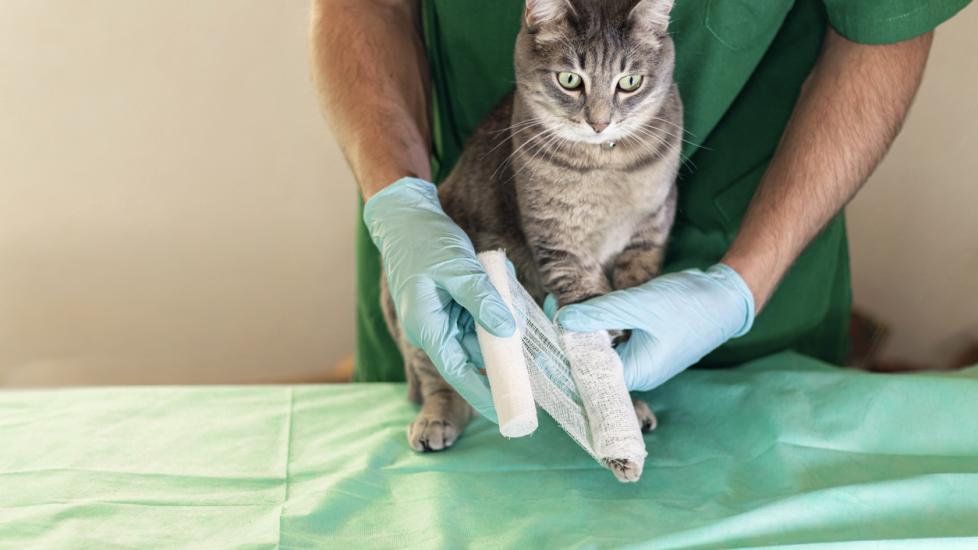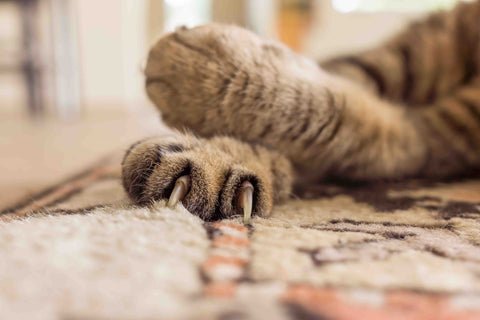As an Amazon Associate I earn from qualifying purchases.
A cat with a broken front radius typically heals in 6-8 weeks. Factors like age, health, and care play a role in recovery time.
Cats are curious and active creatures. Accidents can happen, leading to injuries like a broken bone. If your cat breaks its front radius, you might worry about the healing process. Understanding the recovery timeline and what to expect can ease your concerns.
This blog will cover how long it takes for a cat’s broken front radius to heal. We’ll also discuss ways to support your cat during recovery. Knowing this information will help you care for your pet better and ensure a smoother healing journey.

Credit: www.petmd.com
Introduction To Feline Radius Fractures
A fracture in the front radius of a cat can be a serious issue. The radius is one of the main bones in a cat’s forelimb. It supports a lot of weight. A break in this bone can cause severe pain and mobility issues.
Common Causes
There are several common causes of feline radius fractures:
- Falls: Cats can get injured from falling from heights.
- Car Accidents: Getting hit by a vehicle can break their bones.
- Physical Trauma: Fights with other animals can lead to fractures.
- Bone Disease: Conditions like osteoporosis can weaken bones.
Symptoms To Watch For
Recognizing the symptoms is crucial for timely treatment:
- Limping: Your cat may not put weight on the injured leg.
- Swelling: The affected area may appear swollen.
- Pain: Your cat may show signs of pain when the area is touched.
- Deformity: The leg may look out of shape.
- Lethargy: Your cat may seem less active than usual.
Understanding these causes and symptoms can help you act quickly. Early intervention is key for a good recovery.
Initial Steps After The Fracture
When a cat breaks its front radius, it is crucial to act quickly. Immediate action can significantly impact the healing process. Here are the initial steps you should take after the fracture.
Immediate Actions
If your cat has broken its front radius, keep calm. Minimize movement to avoid further injury. Wrap the cat in a towel or blanket. This will help keep it still and provide some comfort.
Check for any visible wounds. If there is bleeding, apply gentle pressure with a clean cloth. Avoid giving your cat any medications or food. This will be important for the vet’s treatment plan.
Seeking Veterinary Care
Contact your vet immediately. A broken front radius requires professional attention. Explain the situation clearly. Follow their instructions carefully. Transport your cat safely to the vet’s office. Use a secure carrier to avoid more stress and movement.
Once at the vet, they will assess the injury. This may include x-rays to understand the fracture. Treatment options could range from splints to surgery. Your vet will guide you through the best course of action.
Diagnosis And Treatment Options
When a cat breaks its front radius, it is crucial to diagnose the injury promptly and provide appropriate treatment. The radius is one of the two bones in the forearm. A break can cause significant pain and mobility issues for your cat. Understanding the diagnosis and treatment options is vital for ensuring a smooth recovery.
Diagnostic Tests
Veterinarians use several tests to diagnose a broken radius. The first step involves a thorough physical exam. The vet examines the injured area for swelling, bruising, and abnormal movement.
X-rays are the most common diagnostic tool. They provide a clear image of the bone and the break. Sometimes, a vet may use a CT scan for more detailed images. This helps in assessing complex fractures. Blood tests may also be necessary. They check for any infections or underlying health issues that might affect healing.
Treatment Methods
Treatment depends on the severity of the break. For minor fractures, a simple splint or cast may be enough. This keeps the bone in place while it heals. The cat should rest and avoid any activity that could worsen the injury.
Severe fractures often require surgery. In these cases, pins, plates, or screws might be used. They help in stabilizing the bone. The vet will also prescribe pain medication to manage discomfort.
Physical therapy is also important for recovery. Simple exercises can help your cat regain strength and mobility. Always follow the vet’s advice closely to ensure the best outcome for your cat.

Credit: idahohumanesociety.org
Surgical Vs. Non-surgical Approaches
Understanding the best treatment for a cat with a broken front radius is crucial. Deciding between surgical and non-surgical approaches can impact the healing time and overall recovery. Each method has its benefits and specific circumstances under which it is recommended. Let’s explore both options to help you make an informed decision for your feline friend.
When Surgery Is Needed
Surgery is often the best choice for severe fractures. If the bone is shattered or displaced, surgical intervention may be necessary. Surgery helps to realign the bones and stabilize them with pins, plates, or screws. This method can ensure proper healing and function of the limb.
Here are some situations where surgery might be needed:
- Complex fractures with multiple bone fragments
- Open fractures where the bone breaks through the skin
- Fractures that do not align properly
- Non-healing fractures after initial treatment
In these cases, surgery can provide a faster and more reliable recovery. Post-surgery, your cat will need strict rest and monitoring to ensure proper healing.
Non-surgical Treatments
Non-surgical treatments are suitable for less severe fractures. These methods include splinting or casting the affected limb. The goal is to immobilize the bone to allow natural healing.
Non-surgical options are usually recommended for:
- Simple fractures with a single break
- Minor displacements
- Young cats with excellent healing capacity
- Owners who prefer less invasive methods
Here’s a comparison of surgical and non-surgical approaches:
| Treatment Type | Best For | Healing Time | Cost |
|---|---|---|---|
| Surgical | Severe fractures, multiple fragments | 6-8 weeks | Higher |
| Non-Surgical | Simple fractures, minor displacements | 6-12 weeks | Lower |
Both approaches require follow-up visits to the vet. Monitoring the healing process and adjusting the treatment plan if needed is essential for a full recovery.
Recovery Timeline
When a cat breaks its front radius, understanding the recovery timeline is crucial. This helps pet owners provide the best care. Let’s explore the factors that influence healing and the average time for recovery.
Factors Influencing Healing
Several factors influence the healing of a cat’s broken front radius. Age plays a significant role. Younger cats often heal faster. The severity of the fracture also affects the recovery time. Simple fractures heal quicker than complex ones. The overall health of the cat is another factor. Cats in good health recover faster.
Average Healing Time
The average healing time for a broken front radius in cats varies. Generally, it takes about six to eight weeks. Some cases might take longer, especially if the fracture is severe. Proper care and follow-up with a vet ensure a smooth recovery.
At-home Care Tips
Caring for a cat with a broken front radius requires patience and attention. The healing process can take several weeks. Providing the right at-home care will help your cat recover faster and more comfortably.
Creating A Safe Space
Your cat needs a quiet and comfortable area to rest. This space should be free from hazards. Avoid stairs and high surfaces. Use soft bedding to support the injured leg. Keep the area warm and free from drafts. Ensure easy access to food and water.
You might want to use a crate or small room. This limits your cat’s movement. It helps in preventing further injury. Place the litter box nearby. Avoid any high-sided boxes.
Diet And Nutrition
Proper diet and nutrition are essential for healing. Provide high-quality cat food. Ensure it contains enough protein. Protein aids in tissue repair. Include vitamins and minerals. Calcium and phosphorus are vital for bone health.
Consider adding supplements if advised by your vet. Omega-3 fatty acids can reduce inflammation. Avoid overfeeding. Weight gain can stress the injured limb. Provide fresh water at all times. Hydration is crucial for recovery.
| Key Nutrients | Benefits |
|---|---|
| Protein | Supports tissue repair |
| Calcium | Strengthens bones |
| Phosphorus | Aids in bone health |
| Omega-3 Fatty Acids | Reduces inflammation |
Monitoring Progress
Monitoring your cat’s progress after a broken front radius is crucial. It helps ensure proper healing and prevents complications. Regularly checking for signs of improvement can provide peace of mind. Knowing when to contact your vet can make a significant difference in your cat’s recovery.
Signs Of Improvement
Look for gradual improvements in your cat’s behavior. Increased movement and activity are positive signs. Reduced swelling around the injured area indicates healing. Your cat may start putting weight on the affected leg. Appetite and normal grooming habits returning are also good signs.
Observe any changes in pain levels. Less vocalization or hissing when touching the injured leg suggests improvement. Monitor for signs of infection. This includes unusual discharge or persistent swelling. Consistent progress over time is a good indicator of recovery.
When To Contact Your Vet
Contact your vet if you notice any setbacks. Increased swelling, redness, or discharge could indicate infection. Persistent pain or refusal to use the leg is a concern. If your cat stops eating or drinking, seek veterinary advice.
Unusual behavior changes, like hiding or aggression, may need vet attention. If there’s no improvement after a few days, consult your vet. Regular check-ups ensure the healing process is on track. Your vet can provide guidance and adjust treatment if needed.
Preventing Future Injuries
After a cat breaks its front radius, healing is crucial. But preventing future injuries is equally important. Cats are curious and active. They can easily get into trouble. Below are some steps to help keep your cat safe.
Safety Precautions
- Remove hazards: Clear sharp objects and small items that can be swallowed.
- Supervise outdoor activities: Keep an eye on your cat when it is outside. Try to limit its exposure to dangerous areas like busy roads.
- Secure windows and balconies: Install screens or barriers to prevent falls from heights.
- Use pet-friendly furniture: Ensure that furniture is sturdy and does not tip over easily.
- Provide a safe space: Create a quiet and safe area where your cat can rest and heal.
Strengthening Exercises
Once your cat has healed, start with gentle exercises. These help build strength and flexibility.
- Playtime: Use toys that encourage movement, like feather wands or laser pointers.
- Climbing structures: Provide cat trees or shelves. These help improve climbing skills safely.
- Interactive puzzles: Use food puzzles to keep your cat mentally and physically active.
- Short walks: If your cat is comfortable, use a harness and leash for short outdoor walks.
Consistency is key. Incorporate these activities into your cat’s daily routine. This helps maintain their physical health and prevents future injuries.

Credit: www.reddit.com
Frequently Asked Questions
How Long Does A Cat’s Broken Radius Take To Heal?
A cat’s broken radius usually takes around 6 to 8 weeks to heal. The healing time can vary based on the severity of the fracture and the cat’s age.
What Are The Signs Of A Broken Radius In Cats?
Signs include limping, swelling, and an unwillingness to use the affected leg. You may also notice the cat hiding or showing signs of pain.
Can A Cat Walk With A Broken Radius?
A cat may try to walk with a broken radius, but it will likely limp and show discomfort. Immediate veterinary care is essential to prevent further injury.
How Is A Broken Radius Treated In Cats?
Treatment includes immobilization with a splint or cast, and sometimes surgery. Pain management and restricted movement are crucial for proper healing.
Conclusion
Healing a cat’s broken front radius takes patience. Follow your vet’s advice closely. Provide a comfortable, quiet space for recovery. Ensure your cat stays calm and avoids jumping. Regular check-ups with the vet are essential. Proper care helps speed up the healing process.
Soon, your cat will be back to its playful self.
As an Amazon Associate, I earn from qualifying purchases.


